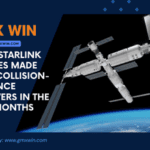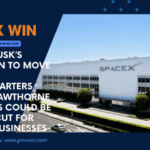SpaceX’s Starlink project is an ambitious effort to provide global high-speed internet coverage through a vast constellation of small satellites in low Earth orbit (LEO). With the deployment of thousands of these satellites, the challenge of avoiding collisions in the increasingly crowded space environment has become critical. Recent reports indicate that Starlink satellites are performing an average of 275 collision-avoidance maneuvers daily. This article explores the significance of these maneuvers, the technology and strategies behind them, and the broader implications for space traffic management and satellite operations.
The Starlink Constellation: An Overview
Vision and Objectives
Elon Musk envisioned Starlink as a solution to the persistent problem of global internet accessibility. By creating a network of small, cost-effective satellites, SpaceX aims to deliver high-speed internet to remote and underserved regions, thereby bridging the digital divide.
Deployment Milestones
Since the first launch in 2019, SpaceX has rapidly expanded the Starlink constellation. As of mid-2024, over 4,000 satellites are in orbit, providing coverage to numerous regions worldwide. This aggressive deployment schedule has been instrumental in establishing Starlink as a major player in the satellite internet market.
Technological Innovations
Several technological advancements underpin Starlink’s success:
- Smallsats: Compact satellites equipped with advanced communication and propulsion systems.
- Phased-Array Antennas: Enabling high-speed data transmission and seamless connectivity.
- Reusability: The use of reusable rockets like the Falcon 9 significantly reduces launch costs and accelerates deployment.
Collision-Avoidance: A Growing Necessity
The Space Debris Challenge
The increasing number of satellites in orbit has led to a heightened risk of collisions. Space debris, including defunct satellites, spent rocket stages, and other fragments, poses a significant threat to operational satellites. The Kessler Syndrome, a scenario where the density of objects in low Earth orbit leads to a cascade of collisions, is a looming concern.
Collision-Avoidance Maneuvers
To mitigate the risk of collisions, satellites are equipped with propulsion systems that allow for precise adjustments to their orbits. These collision-avoidance maneuvers, also known as conjunction assessments, involve tracking potential collision threats and executing corrective actions to maintain safe distances.
SpaceX’s Approach
SpaceX has implemented an advanced system for monitoring and managing collision risks for the Starlink constellation. This includes:
- Automated Tracking: Utilizing ground-based radar and space-based sensors to track objects and predict potential collisions.
- AI and Machine Learning: Leveraging artificial intelligence to analyze data and make real-time decisions for collision avoidance.
- Proactive Maneuvers: Regularly adjusting satellite orbits to preemptively avoid potential threats.
275 Daily Maneuvers: Managing a Dynamic Environment
The Scale of Operations
Executing an average of 275 collision-avoidance maneuvers daily highlights the complexity and scale of Starlink operations. This figure underscores the proactive measures SpaceX is taking to ensure the safety and longevity of its satellites.
Coordination and Execution
The successful execution of these maneuvers requires meticulous coordination:
- Real-Time Data: Continuously monitoring orbital data to identify and predict potential collisions.
- Rapid Response: Implementing maneuvers swiftly to adjust satellite trajectories and avoid collisions.
- Redundancy and Reliability: Ensuring that satellites have multiple propulsion systems and backup mechanisms to perform maneuvers reliably.
Technological Backbone
Several technological components underpin SpaceX’s ability to perform these maneuvers:
- Ion Thrusters: Efficient propulsion systems that allow for precise orbital adjustments.
- Automated Systems: Software and algorithms that autonomously detect and respond to collision threats.
- Ground Control: A dedicated team of engineers and operators who oversee and manage satellite operations.
Implications for Space Traffic Management
Enhancing Safety Standards
The scale and frequency of Starlink’s collision-avoidance maneuvers set a new benchmark for safety standards in the satellite industry. By demonstrating the feasibility of proactive collision management, SpaceX is paving the way for other satellite operators to adopt similar practices.
Regulatory Considerations
The increasing activity in space necessitates robust regulatory frameworks:
- International Cooperation: Collaboration between countries and space agencies to share data and coordinate collision-avoidance efforts.
- Licensing and Compliance: Ensuring that satellite operators adhere to strict guidelines for collision avoidance and debris mitigation.
- Long-Term Sustainability: Developing policies that promote the sustainable use of space and minimize the creation of new debris.
Future Technologies
Innovation will continue to play a crucial role in managing space traffic:
- Advanced Sensors: Developing more sensitive and accurate sensors to detect smaller debris.
- AI-Driven Solutions: Enhancing AI algorithms to improve the accuracy and efficiency of collision predictions and maneuvers.
- Space Debris Removal: Exploring technologies for actively removing debris from orbit, such as robotic arms and harpoons.
Broader Impact on Satellite Operations
Operational Efficiency
Effective collision-avoidance strategies enhance the overall efficiency and reliability of satellite operations:
- Reduced Downtime: Minimizing the risk of collisions reduces the likelihood of service disruptions.
- Extended Lifespan: Protecting satellites from damage ensures their longevity and maximizes their
operational lifespan.
- Cost Savings: Avoiding collisions and reducing the need for replacement satellites lowers operational costs.
Market Competitiveness
SpaceX’s proactive approach to collision avoidance strengthens its competitive position in the satellite market:
- Customer Trust: Demonstrating a commitment to safety and reliability builds trust with customers and stakeholders.
- Industry Leadership: Setting industry standards for collision-avoidance practices reinforces SpaceX’s leadership in the space industry.
- Innovation and Growth: Continual innovation in collision-avoidance technologies and practices drives growth and attracts new business opportunities.
Environmental Responsibility
Proactive collision-avoidance measures contribute to the responsible and sustainable use of space:
- Debris Mitigation: Reducing the risk of collisions helps prevent the creation of additional space debris.
- Sustainable Operations: Implementing best practices for collision avoidance supports the long-term sustainability of satellite operations.
- Global Collaboration: Promoting international cooperation and sharing best practices enhances global efforts to protect the space environment.
Collision-Avoidance Maneuvers: How They Work
Detection and Tracking
SpaceX utilizes a combination of ground-based radar and space-based sensors to detect and track objects that pose a potential collision threat. This involves:
- Data Collection: Gathering orbital data from various sources, including the U.S. Space Surveillance Network (SSN) and other international tracking systems.
- Object Cataloging: Maintaining an updated catalog of space objects, including both active satellites and debris.
Risk Assessment
Once potential threats are detected, risk assessment involves:
- Conjunction Analysis: Calculating the probability of collision based on the relative positions and velocities of objects.
- Predictive Modeling: Using sophisticated algorithms to predict future positions and assess the likelihood of collision.
Decision-Making Process
The decision-making process for collision-avoidance maneuvers includes:
- Automated Systems: Leveraging AI and machine learning to analyze data and make real-time decisions for maneuver execution.
- Human Oversight: Ensuring that engineers and operators review and validate automated decisions to maintain safety and reliability.
Maneuver Execution
Executing collision-avoidance maneuvers involves:
- Propulsion Activation: Using ion thrusters or other propulsion systems to adjust satellite trajectories.
- Orbit Adjustment: Making precise changes to the satellite’s orbit to ensure a safe distance from potential threats.
- Monitoring and Verification: Continuously monitoring the satellite’s new position to verify successful maneuver execution.
Challenges and Solutions
Technical Challenges
Managing collision-avoidance maneuvers presents several technical challenges:
- Sensor Accuracy: Ensuring that sensors provide accurate and reliable data for tracking and prediction.
- Algorithm Efficiency: Developing efficient algorithms that can quickly and accurately assess collision risks.
- System Reliability: Maintaining the reliability and redundancy of propulsion systems to ensure successful maneuver execution.
Operational Challenges
Operational challenges include:
- Coordination: Coordinating maneuvers for thousands of satellites in the constellation to avoid potential collisions with each other.
- Communication: Ensuring seamless communication between satellites and ground control for real-time decision-making.
- Resource Management: Managing the limited fuel and power resources of satellites to optimize maneuver frequency and effectiveness.
Regulatory and Policy Challenges
Regulatory and policy challenges involve:
- International Collaboration: Fostering cooperation between countries and space agencies to share data and coordinate collision-avoidance efforts.
- Standardization: Developing and adhering to international standards and guidelines for collision-avoidance practices.
- Compliance: Ensuring compliance with regulatory requirements and licensing conditions for satellite operations.
Future Prospects for Collision Avoidance
Technological Advancements
Future advancements in technology will enhance collision-avoidance capabilities:
- Improved Sensors: Developing more sensitive and accurate sensors to detect smaller debris and improve tracking accuracy.
- Enhanced AI: Leveraging advancements in AI and machine learning to improve predictive modeling and decision-making processes.
- Autonomous Systems: Exploring autonomous satellite systems that can independently detect and avoid collision threats without human intervention.
Policy and Regulation
Evolving policies and regulations will shape the future of collision avoidance:
- Global Standards: Establishing and enforcing global standards for collision-avoidance practices and debris mitigation.
- Data Sharing: Promoting international data-sharing agreements to enhance situational awareness and coordination.
- Sustainability Initiatives: Implementing sustainability initiatives to minimize the creation of new debris and promote responsible space operations.
Collaboration and Partnerships
Collaboration and partnerships will be key to addressing the challenges of collision avoidance:
- International Cooperation: Strengthening international cooperation between space agencies, satellite operators, and tracking organizations.
- Public-Private Partnerships: Fostering partnerships between government agencies and private companies to develop and implement advanced collision-avoidance technologies.
- Research and Development: Investing in research and development to explore innovative solutions for space traffic management and debris mitigation.
Conclusion
The report that SpaceX’s Starlink satellites perform an average of 275 collision-avoidance maneuvers daily highlights the complexity and scale of managing a large satellite constellation in an increasingly crowded space environment. This proactive approach to collision avoidance sets new standards for safety, reliability, and sustainability in the satellite industry. As the Starlink constellation continues to grow, SpaceX’s efforts in collision avoidance will play a crucial role in ensuring the long-term viability of satellite operations and the responsible use of space.
The success of these maneuvers is a testament to SpaceX’s technological prowess and operational efficiency. It also underscores the importance of robust space traffic management practices in navigating the evolving landscape of satellite technology and global connectivity. Looking to the future, continued innovation, international cooperation, and responsible stewardship of space will be essential in addressing the challenges of collision avoidance and ensuring the sustainable use of space for generations to come.



